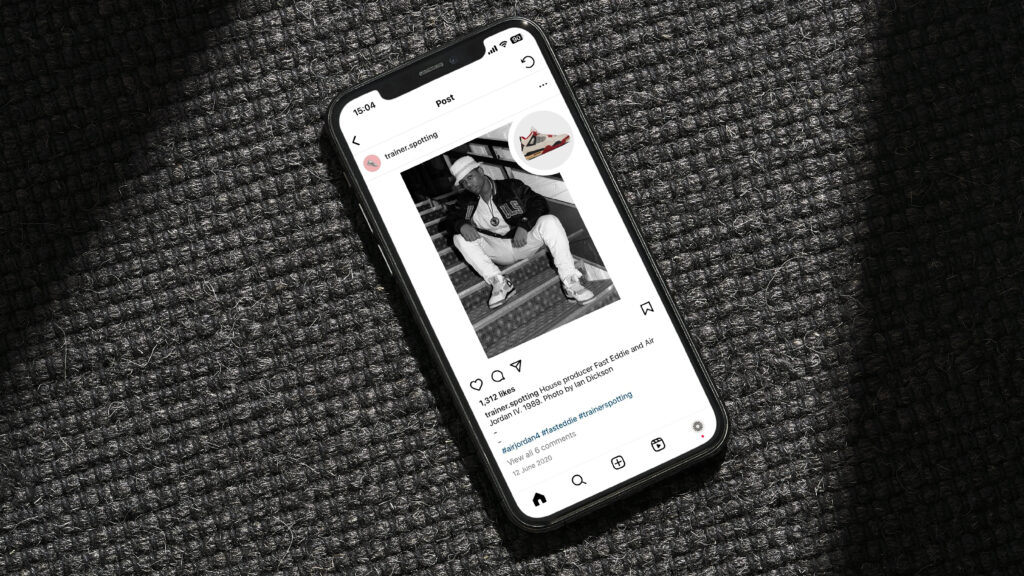The Instagram sneaker sleuth shares his insight on casual footwear’s universal appeal.
From grandmas to Golden Globe winners, everyone owns a pair of sneakers, with the latter being photographed in their casual shoes at various points throughout history. Before celebrities had their every move tracked, papped and posted, images had to be printed, leaving many lost to attic archives or the far corners of the internet.
That was until Trainer Spotting came along, the Instagram account fueling our thirst for nostalgia by chronicling retro celebrity sneaker snaps. To do this, he trawls through Instagram, Tumblr, online forums, magazines and books to unearth new images of the shoes in the wild. Whether it’s a subcultural appeal, performance-focused design or their prominence in film and TV, there’s something about trainers that people just can’t get enough of.
Training shoes, or trainers, have risen from the footwear choice for sporting activities to the most popular style for both men and women, according to The Independent.
The shift from athletics to aesthetics is due to several factors, notably limited-edition releases and the adoption of sneakers by high-profile public figures. Sought-after colourways and collaborations have propelled the sports shoe into the mainstream and, in some cases, moved the sneaker from an everyday commodity into a highly valuable collectable.

Please could you introduce yourself?
My name is Sergey. I do marketing stuff for a living, mostly in the sneaker/streetwear field. I love sneakers and have worked with them for many years, but I’m not a collector.
What is Trainer Spotting, and how did it start?
Trainer Spotting started in 2018 as an outlet for a vast archive of “sneaker moment” pictures I happened to accumulate over the years. I like to see it as a research project about sneakers in culture and fashion, but sometimes it’s simply about good photography or some funny moments.
There doesn’t seem to be the same engagement with other footwear styles. What do you think it is about sneakers that makes them so culturally identifiable and something you wish to pursue?
The obvious answer is that sneakers have really deep connections to subcultures, which gives them all this cultural significance. But another important thing, in my opinion, is the sneaker industry’s approach to design. They are initially designed with performance in mind, not fashion trends. Like good cars or good architecture, good sneaker models stay [relevant] for years and decades.
How important is sport in the rise of sneakers in popular culture?
Sport is a big part of pop culture, it was crucial for sneakers’ rise obviously. What’s more interesting to me is which types of sports put sneakers in the spotlight. The usual suspects are superstar sports like basketball, tennis, and football in the UK. But there were also such things as jogging in the 1970s and aerobics in the 1980s, both helped to legitimise sneakers as acceptable footwear for a really wide audience. My favourite example is the New York City transit strike of 1980. It was famously the first time when thousands of New Yorkers came to offices wearing sneakers. Sneakers instantly became an everyday shoe. But it only was possible because all these people already had sneakers in their wardrobes. And they had them because of the 1970s jogging boom.
What is your favourite sneaker moment you have discovered since starting Trainer Spotting?
There are so many of them. If I have to pick one, I will probably go with Brian De Palma wearing a rare UK-made version of New Balance 998 on the set of “Mission: Impossible”. Just because of the joy of discovering something really special and rare.

What is the significance of film and TV on sneakers?
It was big in the early years, when TV and Film had a greater impact on people’s personal taste. Like [the] Nike Senorita Cortez worn by Farrah Fawcett on the set of “Charlie’s Angels” had an immediate and dramatic impact on sales in the 1970s. Today I feel like product placement has become so common that it oversaturated the market a bit.
How important are celebrity brand partnerships for a sneaker’s popularity?
It’s good marketing, and sometimes such partnerships result in some really interesting releases. Some celebrities have an on-point vision for a good sneaker collaboration. What it usually lacks is a performance-first design mindset, which for me personally, is a really important, essential thing for a good sneaker design.
Since starting Trainer Spotting, have you noticed any patterns with current trends and the archival shots you have uncovered?
These patterns are going in line with global trend cycles. There was a 2000s revival recently, and some pictures from that era started to look like they were shot nowadays.

What is your favourite sneaker, and why?
In terms of my personal daily choice, I’m pretty conservative and for many years stay with retro running silhouettes. In terms of global significance, I think Nike Zvezdochka was a turning point in sneaker design. Its modular concept is still ahead of the market.
In previous interviews, you have said an image of Iggy Pop wearing Air Max 1s inspired you to start the page. Now 36 years old, how significant is the AM1 in modern sneaker culture?
Air Max 1 put sneaker technology in the spotlight like no other shoe. The model was probably more important in terms of marketing rather than actual performance, but it changed the perception of sneakers. Not just “sporty” anymore, sneakers became somewhat of avant-garde footwear, visually stunning. The concept that eventually paved the way for sneakers into the fashion world in my opinion.

What do you feel is the key to a sneaker withstanding the test of time?
A proper, performance-driven design. Functional design ages better than the one responding only to current trends.
With heritage sneakers now extremely popular, are there any other styles you can see making a comeback?
Mules obviously became big recently. An obscure trend from the late ‘90s and early 2000s.
